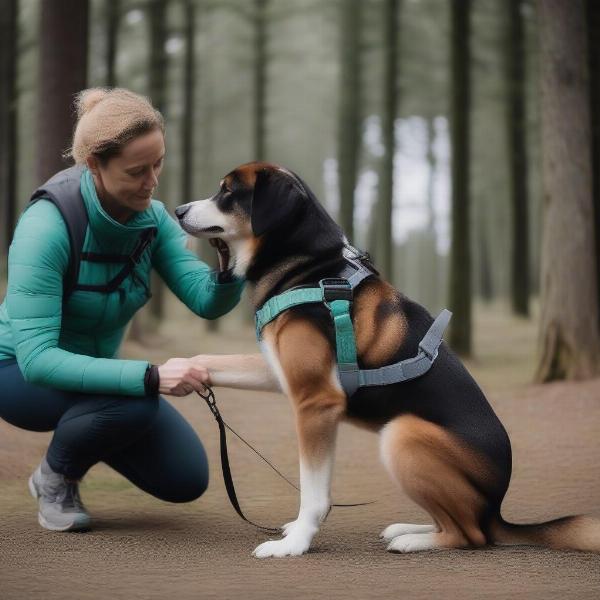Front clip dog harnesses are becoming increasingly popular among dog owners, and for good reason. They offer a gentler, more effective way to manage pulling and offer better control than traditional collars or back-clip harnesses. Whether you’re a new dog owner or a seasoned pro, understanding the benefits of a front clip harness can significantly improve your dog walking experience. This guide covers everything you need to know about front clip harnesses, from choosing the right one to proper usage and training techniques.
Understanding the Benefits of a Front Clip Harness
Traditional collars can put pressure on a dog’s delicate throat, potentially leading to tracheal damage, especially in small breeds or dogs prone to pulling. Back-clip harnesses, while more comfortable than collars, can inadvertently encourage pulling due to the “opposition reflex.” This reflex causes dogs to push against pressure, which can make walks a struggle. Front clip harnesses, on the other hand, redirect the dog’s forward momentum, gently steering them back towards you when they pull. This discourages pulling without causing discomfort or pain.
Front clip harnesses are also particularly helpful for training puppies and dogs who haven’t yet mastered loose-leash walking. They provide more control and prevent the dog from lunging or chasing after distractions.
Choosing the Right Front Clip Harness
Selecting the right front clip harness is crucial for both comfort and effectiveness. Consider your dog’s breed, size, and activity level. Adjustable harnesses allow for a perfect fit and accommodate growth in puppies. Look for harnesses made of durable, breathable materials, with padded straps for added comfort. Ensure the harness is secure and won’t easily slip off. Measure your dog carefully and refer to the manufacturer’s sizing chart for the best fit.
Introducing Your Dog to the Front Clip Harness
Introducing a new harness should be a gradual process. Start by allowing your dog to sniff and investigate the harness. Reward them with treats and praise for positive interactions. Next, gently put the harness on for short periods, gradually increasing the duration as your dog becomes comfortable. Make sure the harness is snug but not too tight, allowing two fingers to fit between the harness and your dog’s body.
 Dog Owner Fitting Front Clip Harness
Dog Owner Fitting Front Clip Harness
Training with a Front Clip Harness
When walking with a front clip harness, keep the leash loose and avoid jerking or pulling. If your dog starts to pull, gently redirect their attention by changing direction or offering a treat. Consistency and positive reinforcement are key to successful training.
Is a Front Clip Harness Right for My Dog?
Front clip harnesses are a great option for most dogs, especially those who pull or are difficult to control on a leash. However, they may not be suitable for all dogs. For example, brachycephalic breeds (dogs with short noses) may benefit from a different type of harness. Consult with a veterinarian or professional dog trainer if you have any concerns.
Conclusion
A front clip dog harness can be a valuable tool for improving your dog walking experience. By understanding the benefits, choosing the right harness, and using proper training techniques, you can help your dog walk comfortably and safely while enjoying more enjoyable walks together.
FAQ
- How do I know if my front clip harness fits correctly? You should be able to fit two fingers between the harness and your dog’s body. The harness should be snug but not restrictive.
- Can I leave the front clip harness on my dog all the time? It’s generally not recommended to leave a harness on your dog all the time, as it can cause chafing or discomfort.
- What type of leash should I use with a front clip harness? A standard leash is suitable for use with a front clip harness.
- Are front clip harnesses good for puppies? Yes, front clip harnesses can be very helpful for training puppies to walk on a leash.
- My dog is still pulling even with a front clip harness. What should I do? Consistency is key. Continue practicing loose-leash walking techniques and reward your dog for good behavior. Consider consulting with a professional dog trainer for additional guidance.
- Can I use a front clip harness for running with my dog? Yes, many front clip harnesses are suitable for running, but make sure it fits securely and comfortably.
- Are there any disadvantages to using a front clip harness? Some dogs may initially try to paw at the harness or find it unusual. With proper introduction and training, most dogs adapt quickly.
ILM Dog is your one-stop resource for all things dog-related. We offer expert advice on dog breeds, health, training, nutrition, grooming, and much more. Whether you’re a new dog owner or a seasoned pro, ILM Dog is here to help you provide the best possible care for your furry friend. Contact us at [email protected] or +44 20-3965-8624 for personalized advice and discover the wide range of products and accessories we offer.